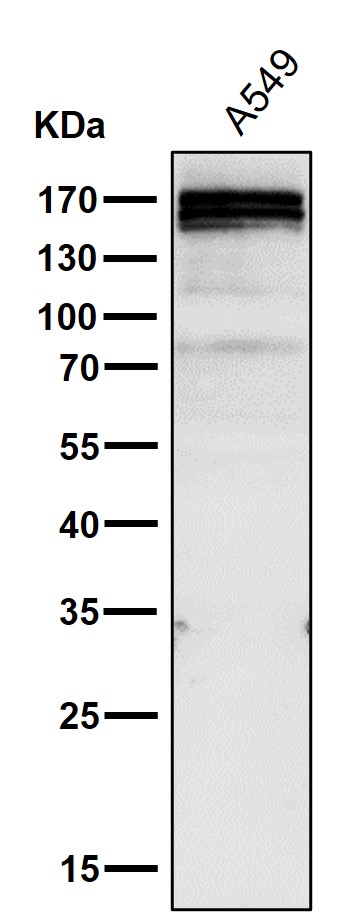
| WB | 1/1000-1/2000 | Human,Mouse,Rat |
| IF | 咨询技术 | Human,Mouse,Rat |
| IHC | 咨询技术 | Human,Mouse,Rat |
| ICC | 技术咨询 | Human,Mouse,Rat |
| FCM | 咨询技术 | Human,Mouse,Rat |
| Elisa | 咨询技术 | Human,Mouse,Rat |
| Aliases | Zinc finger protein GLI1; Glioma-associated oncogene; Oncogene GLI; Zfp5; GLI family zinc finger 1;GLI;;GLI1 |
| WB Predicted band size | Calculated MW: 118 kDa ; Observed MW: 160 kDa |
| Host/Isotype | Rabbit IgG |
| Antibody Type | Primary antibody |
| Storage | Store at 4°C short term. Aliquot and store at -20°C long term. Avoid freeze/thaw cycles. |
| Species Reactivity | Human |
| Immunogen | A synthesized peptide derived from human GLI1 |
| Formulation | Purified antibody in PBS with 0.05% sodium azide,0.05% BSA and 50% glycerol. |
+ +
以下是关于Gli1抗体的3篇参考文献及其摘要概述:
---
1. **文献名称**: "Regulation of Gli1 transcriptional activity in the nucleus by Dyrk1"
**作者**: Sasaki H., et al.
**摘要**: 研究Gli1在Hedgehog信号通路中的转录调控机制,通过Gli1抗体的免疫沉淀和染色质分析,发现Dyrk1激酶通过磷酸化修饰Gli1.增强其转录活性,促进靶基因表达。
---
2. **文献名称**: "A paracrine requirement for Hedgehog signalling in cancer"
**作者**: Yauch R.L., et al.
**摘要**: 利用Gli1抗体检测肿瘤微环境中Hedgehog信号活性,证明基底细胞癌中旁分泌信号依赖Gli1激活,靶向该通路可抑制肿瘤生长,为治疗提供新策略。
---
3. **文献名称**: "The Hedgehog-Gli pathway regulates dorsal brain growth and tumorigenesis"
**作者**: Dahmane N., et al.
**摘要**: 通过Gli1抗体的免疫组化分析,揭示Hedgehog-Gli通路在小脑发育和髓母细胞瘤发生中的作用,Gli1高表达与脑肿瘤增殖和侵袭性相关。
---
如需更多文献或具体应用场景,可进一步补充说明。
**Background of Gli1 Antibody**
The Gli1 antibody is a crucial tool in studying the Hedgehog (Hh) signaling pathway, a highly conserved cascade regulating cell differentiation, proliferation, and tissue patterning during development. Gli1. a zinc finger transcription factor, acts as a primary mediator of Hh signaling. Unlike other Gli family members (Gli2/Gli3), Gli1 lacks a repressor domain and functions predominantly as a transcriptional activator, amplifying Hh pathway activity. Its expression is tightly linked to pathway activation, making it a reliable biomarker for Hh signaling status.
Gli1 antibodies are widely used in research to detect and quantify Gli1 protein levels in techniques like immunohistochemistry, Western blotting, and immunofluorescence. These antibodies help elucidate Gli1's role in developmental biology, stem cell maintenance, and diseases, particularly cancers (e.g., basal cell carcinoma, medulloblastoma) where aberrant Hh signaling drives tumorigenesis. Additionally, Gli1 is implicated in tissue repair and fibrosis, highlighting its diverse regulatory functions.
Commercial Gli1 antibodies are often validated for specificity across species (human, mouse, rat) and applications. However, variability in epitope recognition or cross-reactivity with other Gli proteins requires careful validation. Research utilizing Gli1 antibodies continues to advance therapeutic strategies targeting Hh pathway inhibitors in oncology and regenerative medicine.
×